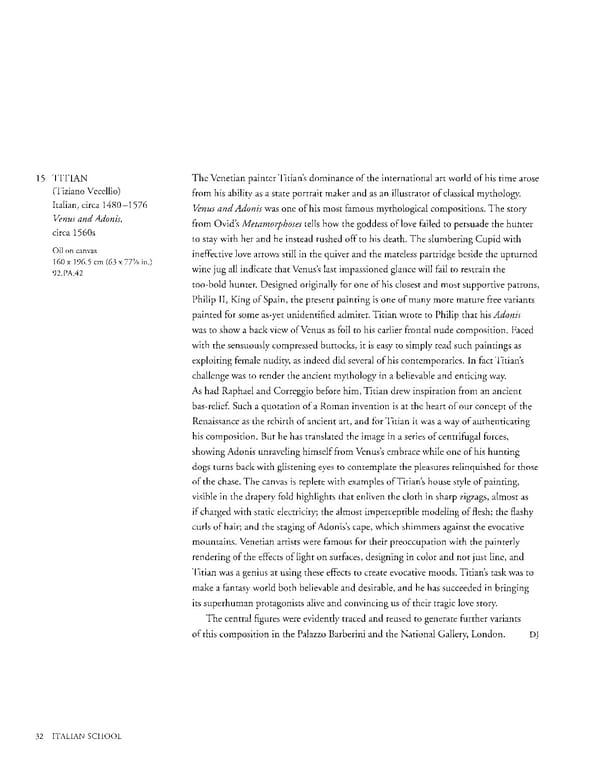15 TITIAN The Venetian painter Titian's dominance of the international art world of his time arose (Tiziano Vecellio) from his ability as a state portrait maker and as an illustrator of classical mythology. Italian, circa 14801576 Venus and Adonis was one of his most famous mythological compositions. The story Venus and Adonis, from Ovid's Metamorphoses tells how the goddess of love failed to persuade the hunter circa 1560s to stay with her and he instead rushed off to his death. The slumbering Cupid with Oil on canvas ineffective love arrows still in the quiver and the mateless partridge beside the upturned 160 x 196.5 cm (63 x 77 in.) 92.PA.42 wine jug all indicate that Venus's last impassioned glance will fail to restrain the toobold hunter. Designed originally for one of his closest and most supportive patrons, Philip II, King of Spain, the present painting is one of many more mature free variants painted for some asyet unidentified admirer. Titian wrote to Philip that his Adonis was to show a back view of Venus as foil to his earlier frontal nude composition. Faced with the sensuously compressed buttocks, it is easy to simply read such paintings as exploiting female nudity, as indeed did several of his contemporaries. In fact Titian's challenge was to render the ancient mythology in a believable and enticing way. As had Raphael and Correggio before him, Titian drew inspiration from an ancient basrelief. Such a quotation of a Roman invention is at the heart of our concept of the Renaissance as the rebirth of ancient art, and for Titian it was a way of authenticating his composition. But he has translated the image in a series of centrifugal forces, showing Adonis unraveling himself from Venus's embrace while one of his hunting dogs turns back with glistening eyes to contemplate the pleasures relinquished for those of the chase. The canvas is replete with examples of Titian's house style of painting, visible in the drapery fold highlights that enliven the cloth in sharp zigzags, almost as if charged with static electricity; the almost imperceptible modeling of flesh; the flashy curls of hair; and the staging of Adonis's cape, which shimmers against the evocative mountains. Venetian artists were famous for their preoccupation with the painterly rendering of the effects of light on surfaces, designing in color and not just line, and Titian was a genius at using these effects to create evocative moods. Titian's task was to make a fantasy world both believable and desirable, and he has succeeded in bringing its superhuman protagonists alive and convincing us of their tragic love story. The central figures were evidently traced and reused to generate further variants of this composition in the Palazzo Barberini and the National Gallery, London. DJ 32 ITALIAN SCHOOL
 Masterpieces of the Getty Museum: Paintings Page 32 Page 34
Masterpieces of the Getty Museum: Paintings Page 32 Page 34